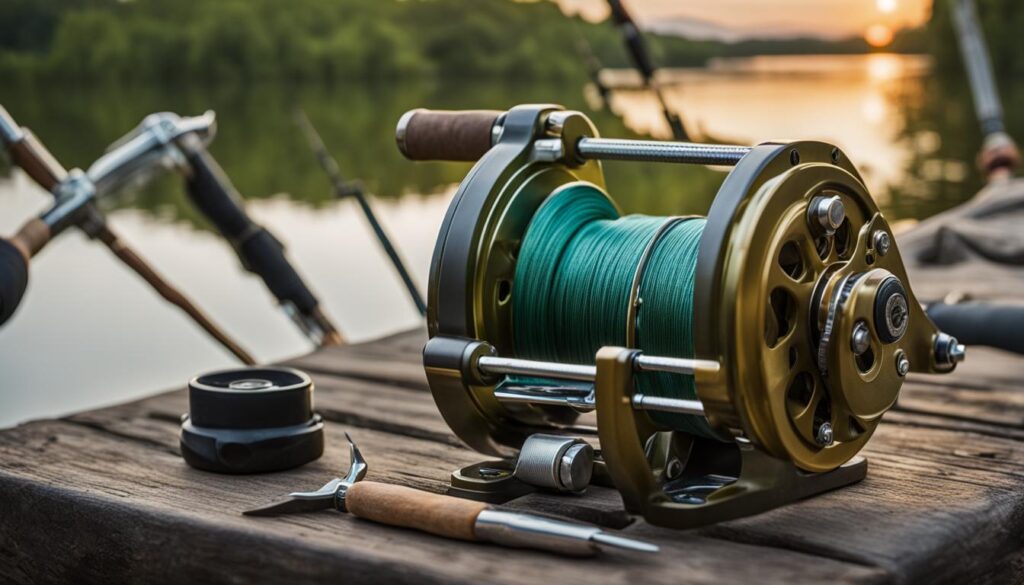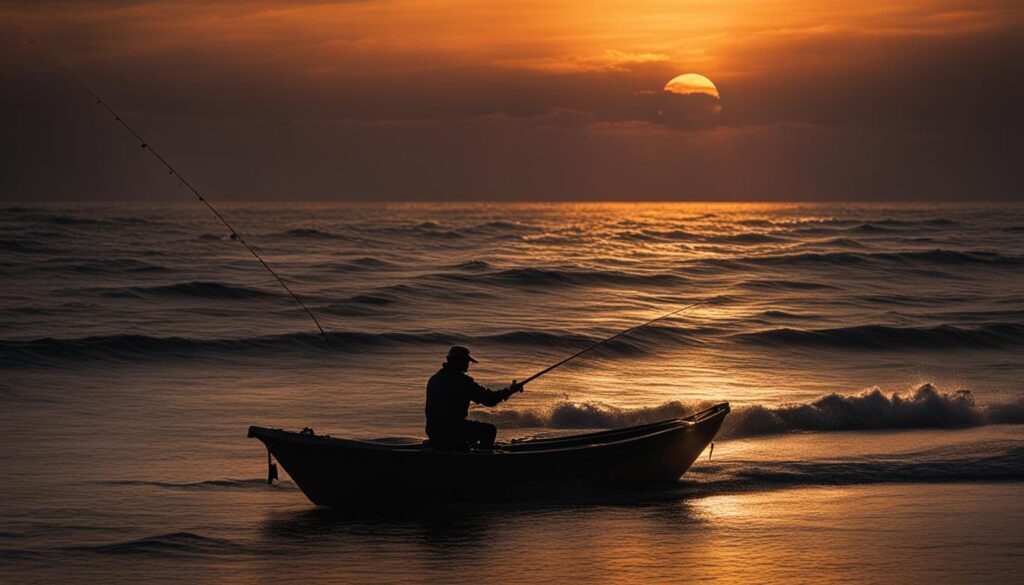We may earn money or products from the companies mentioned in this post.
As an angler, you understand the importance of having reliable fishing gear. To optimize your chances of landing the big one and ensure your gear lasts for many fishing trips to come, proper maintenance and care are essential. In this article, we will provide you with essential tackle maintenance tips to help you master the skill of maintaining your fishing tackle.
By following our tackle care guide, you can enhance your angling success and keep your fishing gear in optimal condition. We will cover everything from the importance of regular maintenance to cleaning and storage tips, reel and rod care, and tackle box organization.
Key Takeaways
- Proper maintenance and care are essential for optimal performance and prolonged lifespan of fishing tackle
- Regular maintenance and cleaning can enhance angling success
- Effective tackle box organization can provide easy access and equipment protection
- Tackle maintenance tips include proper cleaning, storage, and inspection techniques
- Reel and rod care are crucial for optimal performance
Understanding the Importance of Fishing Tackle Maintenance
Proper maintenance of fishing gear is essential for every angler. By regularly maintaining your fishing tackle, you can prolong its lifespan and ensure optimal performance on your next fishing trip. Here are some essential tips on how to maintain your fishing gear:
Develop a Tackle Maintenance Checklist
Creating a tackle maintenance checklist is a simple and effective way to ensure you don’t forget any crucial steps when maintaining your fishing gear. Your checklist should include cleaning, lubrication, and inspection of your reels, rods, and lines. Refer to it before and after every fishing trip to ensure your gear is always in top condition.
Clean Your Gear Regularly
Cleaning your fishing gear after every use is essential to remove dirt, debris, and salt build-up that can damage your equipment. Use mild soap and water to clean your rods, reels, and lines. Avoid using harsh chemicals or abrasives that can scratch or damage your gear.
Inspect Your Gear for Damage
Inspect your fishing gear regularly for signs of wear and damage. Check for cracks, dents, and rust on your rods and reels. If you notice any damage, replace or repair the affected parts immediately to prevent further damage and ensure optimal performance. Check your fishing line for nicks and wear and replace it if necessary.
Store Your Gear Properly
Proper storage of your fishing gear is just as important as cleaning and maintenance. Store your rods and reels in a cool, dry place to prevent rust and damage. Avoid leaving your gear in direct sunlight or extreme temperatures. Keep your fishing lines organized and untangled to prevent kinks and knots.
By following these essential fishing gear maintenance tips, you can ensure your equipment is always in top condition and ready for your next fishing trip.
Cleaning and Storage Tips for Fishing Tackle
Proper maintenance of your fishing gear is crucial to prolonging its lifespan and ensuring optimal performance. In this section, we will discuss the best practices for cleaning and storing your fishing tackle.
Cleaning Your Fishing Tackle
Regular cleaning of your fishing gear is essential to remove dirt, debris, and other substances that may harm your equipment. The cleaning process varies depending on the type of gear you have. Below are some tips on how to clean different types of fishing tackle:
| Type of Tackle | Cleaning Method |
|---|---|
| Rods | Use a soft cloth to remove any dirt or debris. For stubborn dirt, use a mild detergent and warm water. Rinse the rod with water and let it dry completely before storing. |
| Reels | Remove the spool and wipe down the reel with a soft cloth. Use a toothbrush or cotton swab to clean hard-to-reach areas. Apply a small amount of lubricant to the gears and moving parts. Reassemble the reel and store it in a dry place. |
| Lines | Wipe the line with a soft cloth to remove any dirt or debris. For heavily soiled lines, use a mild soap and water solution. Rinse the line with clean water and let it dry before storing. |
| Leaders | Wipe the leader with a soft cloth to remove any dirt or debris. For heavily soiled leaders, use a mild soap and water solution. Rinse the leader with clean water and let it dry before storing. |
| Hooks and Lures | Use a soft cloth to wipe down hooks and lures after each use. If they are heavily soiled, soak them in a mild soap and water solution for a few minutes. Rinse and let them dry before storing. |
Note: Always check the manufacturer’s instructions before cleaning your fishing gear.
Storing Your Fishing Tackle
Proper storage is essential in maintaining the longevity of your fishing gear. Below are some tips for storing your fishing tackle:
- Store your gear in a cool, dry place away from direct sunlight.
- Keep your tackle organized by using a proper tackle box or bag.
- Hang your rods vertically or store them horizontally to prevent warping.
- Store your reels with the drag set to the lowest setting.
- Replace any damaged or worn out parts before storing your gear.
By following these cleaning and storage tips, you can prolong the lifespan of your fishing gear and ensure optimal performance for years to come.
Reel Maintenance: Key Steps for Optimal Performance
When it comes to essential tackle maintenance, proper reel care is critical to prolonging the lifespan of your fishing gear. Neglecting to clean and maintain your reel can lead to decreased performance and even permanent damage.
Step 1: Lubrication
Regular lubrication is key to keeping your reel operating smoothly. Apply reel oil or grease to the moving parts of your reel, including the handle, spool, and gears. Be sure to use the appropriate lubricant for your specific reel type and follow the manufacturer’s recommendations for application frequency and amount.
Step 2: Cleaning
Cleaning your reel after each use is essential to prevent dirt and debris from building up and damaging your gear. Use a soft-bristled brush or toothbrush to gently remove any dirt or debris from the exterior of your reel. You can also use a reel cleaner or warm soapy water to clean the reel more thoroughly. Be sure to dry your reel thoroughly after cleaning to prevent rust from forming.
Step 3: Inspection
Regularly inspecting your reel for damage is crucial to catching any issues early and preventing further damage. Check for signs of wear and tear on the exterior of your reel, as well as any loose or damaged parts. If you notice any issues, consider taking your reel to a professional for repairs.
Step 4: Storage
Proper storage is key to prolonging the lifespan of your reel. Store your reel in a dry, cool place with minimal exposure to sunlight and humidity. Consider using a reel cover to protect your gear from dirt and debris when not in use.
“Neglecting to clean and maintain your reel can lead to decreased performance and even permanent damage.”
By following these key steps for reel maintenance, you can ensure that your reel performs at its best and lasts for years to come. Regularly lubricating, cleaning, inspecting, and storing your reel is essential to essential tackle maintenance and prolonging the lifespan of your gear.
Rod Care: Maintaining the Backbone of Your Gear
Proper maintenance of your fishing rod is essential for ensuring its longevity and optimal performance. Here are some essential tackle maintenance tips for taking care of your fishing rod:
- Clean your rod after every use: Use a soft cloth to wipe down your rod and remove any dirt or debris that may have accumulated during your fishing trip. Avoid using harsh chemicals or abrasive materials that may damage the rod finish.
- Check for damage: Regularly inspect your rod for any signs of damage, such as cracks, chips, or scratches. If you detect any damage, repair it promptly to prevent further deterioration.
- Store your rod properly: Store your rod in a dry, cool place to prevent damage from moisture or heat. Hang your rod vertically or horizontally on a rod rack or in a rod case to avoid bending or warping the rod.
By following these essential tackle maintenance tips, you can prolong the lifespan of your fishing rod and ensure it remains in good condition for years to come.
Tackle Box Organization: A Guide for Easy Access and Equipment Protection
As the saying goes, “a place for everything, and everything in its place.” This is especially true when it comes to organizing your tackle box. Proper tackle box organization can mean the difference between spending more time fishing and less time searching for gear.
Inventory Management
The first step in organizing your tackle box is taking inventory of what you have. This will help you determine what you need to buy, what you can get rid of, and how you can better organize your gear.
Create an inventory list of all the fishing tackle you own, including lures, hooks, sinkers, lines, and other accessories. This will help you keep track of what you have and what you need to purchase. You can keep this list on your phone or in a small notebook that you can bring with you to the tackle shop.
Tackle Box Maintenance
To keep your tackle box in good condition, you should clean it after every fishing trip and check for any damage. Use a soft cloth and mild soap and water to clean the outside of the box. For the inside, remove all the gear and clean it thoroughly with soap and water. Make sure to dry it completely before putting the gear back in.
Tackle Box Layout
Your tackle box should be laid out in a way that makes it easy to access everything you need quickly. Here are some tips for organizing your gear:
- Group similar items together, such as hooks, weights, and lures
- Arrange your gear by size and color for easy identification
- Use small plastic bags or dividers to keep everything separate
- Put frequently used items in easy-to-reach spots
- Label everything so you can find it quickly
Creating a tackle maintenance checklist can help you stay on top of your gear and ensure you have everything you need for a successful fishing trip. Use the checklist to mark off items as you pack them in your tackle box, and make notes of anything you need to purchase or replace before your next trip. This will help you keep your gear in peak condition and maximize your time on the water.
Conclusion
Proper maintenance of your fishing tackle is crucial for any angler looking to improve their success on the water. By following our tackle maintenance tips and properly caring for your gear, you can enhance the performance of your equipment and increase your chances of a successful catch.
We discussed the importance of regular maintenance, cleaning, and storage of your fishing gear. We also provided key steps for maintaining your reel and rod, the backbone of your gear, to ensure optimal performance. Additionally, we provided tips for organizing your tackle box for easy access and effective equipment protection.
Remember always to inspect your gear thoroughly, clean it regularly, and store it properly to prolong its lifespan and ensure optimal performance in the future. By mastering the skill of fishing tackle maintenance, you can enhance your angling success and enjoy your fishing experience to the fullest.
FAQ
What is the importance of fishing tackle maintenance?
Fishing tackle maintenance is crucial for every angler. It helps to enhance angling success, prolong the lifespan of your gear, and ensure optimal performance on the water.
How often should I maintain my fishing gear?
It is recommended to regularly maintain your fishing gear. Cleaning and inspecting after each use, and performing more thorough maintenance at least once a season, will help keep your tackle in excellent condition.
How do I clean my fishing tackle?
Cleaning your fishing tackle involves using mild soap, warm water, and a soft cloth or brush. Thoroughly rinse and dry your gear after cleaning to remove any residue and prevent rust or corrosion.
What should I look for when inspecting my tackle?
When inspecting your tackle, check for any signs of damage, such as rust, loose parts, or frayed lines. Pay attention to the reel’s smoothness, rod’s integrity, and the condition of hooks, lures, and other accessories.
How should I store my fishing tackle?
Proper storage is important to prevent damage and prolong the lifespan of your fishing tackle. Store rods in a vertical position, keep reels lubricated, use dividers in your tackle box, and store your gear in a cool, dry place away from direct sunlight.
What are some tips for organizing my tackle box?
To keep your tackle box organized, create a system for categorizing and labeling your gear. Keep frequently used items easily accessible, utilize small containers for hooks and lures, and regularly assess your inventory to replace or restock items as needed.
How can I ensure optimal performance of my fishing reels?
To maintain optimal performance, lubricate your fishing reels regularly, clean them after each use, and inspect for any signs of wear or damage. Following the manufacturer’s guidelines and using the appropriate lubricants will help ensure smooth operation.
Affiliate Disclosure: This post may contain affiliate links. If you purchase through our link, we may receive a small commission, but at no additional cost to you. For more information, please see our Disclosure statement.



